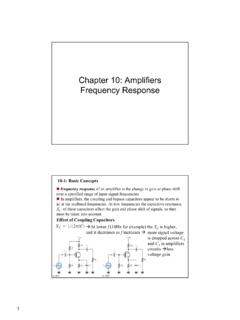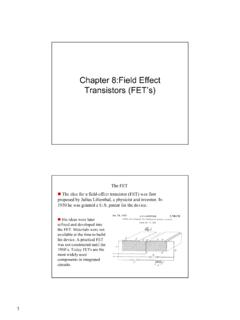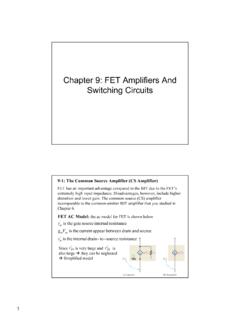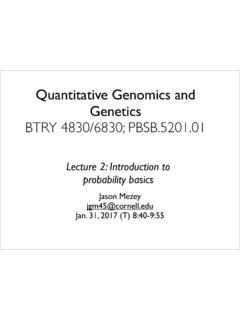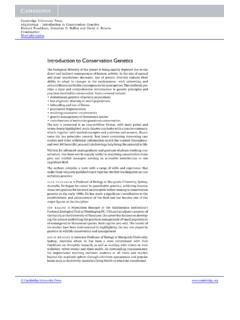Transcription of Introduction to quantitative genetics - An-Najah Staff
1 Purpose and expected outcomesMost of the traits that plant breeders are interested in are quantitatively inherited. It is important to understandthe genetics that underlie the behavior of these traits in order to develop effective approaches for manipulating studying this chapter, the student should be able to:1 Define quantitative genetics and distinguish it from population between qualitative traits and quantitative polygenic gene the variance components of quantitative the concept of heritability of selection and define the breeders the concept of general worth of a the concept of combining quantitative geneticist observes the phenotype, a prod-uct of the genotype and the environment. The genotypicarray depends on mating systems and genetic linkagerelationships, as well as on allelic frequencies, which inturn are impacted by mutation, migration, random drift,and selection (see Chapter 7).
2 To make effective obser-vations about phenotypes, the quantitative geneticisthas to make assumptions about the mating system,allelic frequency altering forces, and the assumptions of quantitative genetic analysisare as follow:1 Reference population defined. Allelic and geno-typic frequencies can only be defined with respect to aspecified population. The researcher should define abase reference population. All inferences made aboutthe estimates should depend upon the compositionof this reference toquantitative geneticsWhat is quantitative genetics ? genetics has several branches, including populationgenetics, quantitative genetics , biometric genetics , andmolecular genetics . Population genetics is an extensionof Mendelian genetics applied at the population genetics does not assign a genotypic ornumerical value to each of the individuals (genotypes) inthe population (except in the case of coefficients ofselection).
3 quantitative genetics , on the other hand, isa branch of genetics in which individual genotypes areunidentified, and the traits of individuals are values are assigned to genotypes in the popu-lation. quantitative genetics emphasizes the role ofselection in controlled populations of known topics of population genetics are often discussedin quantitative genetics books, partly because popula-tion genetics is basic to quantitative 28/8/06 4:08 PM Page 1212 Absence of linkage. It is assumed that the trait (phenotype) observed is not affected by autosomallinkage Presence of diploid Mendelian inheritance. Theplants are assumed to be diploid in which genes segregate and assort independently. Analysis of polyploids is possible, but is involved and Absence of selection during the formation ofinbred lines.
4 In order for the estimates of geneticvariances to pertain to the base reference population,it is required that no selection occur when inbredlines are No breeding of the reference population. It isassumed that the inbreeding coefficient of the refer-ence population is zero. The analysis becomes morecomplex when inbreeding is coupled with more thantwo loci and includes the presence of traitsThe topic of quantitative traits was first discussed inChapter 5. Most traits encountered in plant breedingare quantitatively inherited. Many genes control suchtraits, each contributing a small effect to the overall phe-notypic expression of a trait. Variation in quantitativetrait expression is without natural discontinuities ( ,the variation is continuous).
5 The traits that exhibit con-tinuous variations are also called metric traits. Anyattempt to classify such traits into distinct groups is onlyarbitrary. For example, height is a quantitative trait. Ifplants are grouped into tall versus short plants, onecould find relatively tall plants in the short group and,similarly, short plants in the tall genetics versus quantitative geneticsThe major ways in which qualitative genetics and quan-titative genetics differ may be summarized as:1 Nature of traits. Qualitative genetics is concernedwith traits that have Mendelian inheritance and can be described according to kind and, as previ-ously discussed, can be unambiguously genetics traits are described in terms of the degree of expression of the trait, rather thanthe Scale of variability.
6 Qualitative genetic traits providediscrete (discontinuous) phenotypic variation, whereasquantitative genetic traits produce phenotypic vari-ation that spans the full spectrum (continuous).122 CHAPTER83 Number of genes. In qualitative genetics , the effectsof single genes are readily detectable, while in quanti-tative genetics , single gene effects are not , traits are under polygenic control (genes withsmall indistinguishable effects).4 Mating pattern. Qualitative genetics is concernedwith individual matings and their progenies. Quan-titative genetics is concerned with a population ofindividuals that may comprise a diversity of Statistical analysis. Qualitative genetic analysis isquite straightforward, and is based on counts andratios.
7 On the other hand, quantitative analysis pro-vides estimates of population parameters (attributesof the population from which the sample wasobtained).The environment and quantitative variationAll genes are expressed in an environment (phenotype =genotype +environmental effect). However, quantita-tive traits tend to be influenced to a greater degree thanqualitative traits. It should be pointed out that, undersignificantly large environmental effects, qualitative traits(controlled by one or a few major genes) can exhibit a quantitative trait inheritance pattern (Figure ). Astrong environmental influence causes the otherwisedistinct classes to s classic work involving wheatcolor provided the first formal evidence of genes withcumulative redRedMedium redLight redWhite16 4 141 POPC08 28/8/06 4:08 PM Page 122 Polygenes and polygenic inheritanceQuantitative traits are controlled by multiple genes are polygenes?
8 Polygenesare genes with effects that are too small to beindividually distinguished. They are sometimes calledminor genes. In polygenic inheritance, segregationoccurs at a large number of loci affecting a trait. Thephenotypic expression of polygenic traits is susceptibleto significant modification by the variation in environ-mental factors to which plants in the population are subjected. Polygenic variation cannot be classified intodiscrete groups ( , variation is continuous). This isbecause of the large number of segregating loci, eachwith effects so small that it is not possible to identifyindividual gene effects in the segregating population orto meaningfully describe individual genotypes. Instead,biometrics is used to describe the population in terms of means and variances.
9 Continuous variation is causedby environmental variation and genetic variation due tothe simultaneous segregation of many genes affectingthe trait. These effects convert the intrinsically discretevariation to a continuous one. Biometric genetics is usedto distinguish between the two factors that cause con-tinuous variability to aspect of polygenic inheritance is that differ-ent combinations of polygenes can produce a particularphenotypic expression. Furthermore, it is difficult tomeasure the role of the environment on trait expressionbecause it is very difficult to measure the environmentaleffect on the plant basis. Consequently, a breederattempting to breed a polygenic trait should evaluatethe cultivar in an environment that is similar to that prevailing in the production region.
10 It is beneficial to plant breeding if a tight linkage of polygenes (called polygenic blockor linkage block) that hasfavorable effects on traits of interest to the breeder is 1910, a Swedish geneticist, Nilsson-Ehle provideda classic demonstration of polygenic inheritance and in the process helped to bridge the gap between ourunderstanding of the essence of quantitative and quali-tative traits. Polygenic inheritance may be explained bymaking three basic assumptions:1 Many genes determine the quantitative genes lack action of the genes are crossed two varieties of wheat, one withdeep red grain of genotype R1R1R2R2, and the otherwhite grain of genotype r1r1r2r2. The results are sum-marized in Table He observed that all the seed ofthe F1was medium red.




